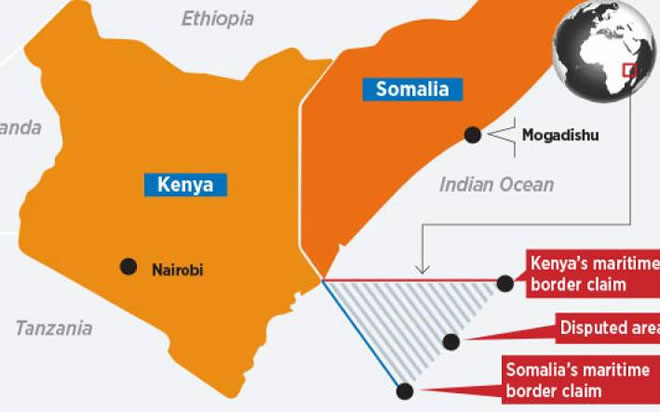by Hassan YusufWaal
Friday, June 7, 2019

The Indian Ocean maritime boundary dispute between Somalia and Kenya has reached a new level of intensity. While Somalia is holding out an olive branch to de-escalate the spat Kenya has actually added fuel to the fire.
On February, 17 2019, Kenya expelled Somalia’s ambassador to Kenya and recalled its ambassador to Mogadishu. On May 21 2019 Kenya detained and confiscated the passports of Somali ministers and MPs who were entering in Kenya. On May 29, 2019 Kenya banned cargo goods from Somalia and ordered all the planes from Somalia to be diverted to Wajir county airport for security checks.
The motive behind Kenya’s unfortunate actions is to pressure Somalia to abandon a case submitted to International Court of Justice by Somalia. In 2014 Somalia took the matter to ICJ to settle maritime dispute between her and its neighbour after several attempts of alternative dispute resolution had failed.
According to an article published by Reuters Kenya has already granted hydrocarbon exploration and exploitation rights to many companies including Tullow, Erin Energy, FAR and Dominion in the Indian Ocean disputed area. Kenya knows what she did is illegal and that ICJ will highly likely rule in favour of Somalia. Therefore Kenya is desperately trying that Somalia withdraws its case at the ICJ.
Kenya’s maximum pressure strategy has so far failed as Somalia is not giving in to the pressure. Kenya has still some weapons at its disposal to hit hard Somalia at least in the short term including a closure of Dadaab refugee camp and a kick out of Somali investors- a risky scenario though that could backfire. Kenya benefits massively from both the largest refugee camp in the world and the investment of Somali business community. So what is Kenya’s next move ahead of ICJ ruling scheduled for September 2019?
As some surveys carried out suggest there are deposits of oil and gas in the maritime disputed area between Somalia and Kenya. Hence Kenya had long planned since the early 2000s to invade and capture the strategic port city of Kismayo-the capital city of Jubaland state of Somalia. In January 2010 According to Wikileaks Kenya’s former Foreign Minister, Moses Wetangula requested the USA government to help Kenya to invade in Somalia in order to create Jubaland state. Washington however was not enthusiastic about the idea and refused Kenya’s request to invade in Somalia.
In October 2011, according to Kenya, they invaded into Somalia to create a buffer zone to protect its territory from Al-shabaab. But the main objective of Kenya’s invasion in Jubaland was a military strategy of control and influence and the creation of a quasi independent state- a political entity that undermines Villa Somalia. Kenya helped the former Al-shabaab ally leader Ahmed Madobe to become the president of Jubaland state.